“Hey Siri” Not Working? Try these 20 Unique Solutions
Siri might not work mainly due to the misconfiguration of its features or as a result of network problems. The misconfigured features ranged from Type to Siri to Sound Recognition. The problem appears when you say Hey Siri but either Siri does not respond or if it responds, then does not perform the task required. In some cases, the issue surfaced after an OS update. The issue is reported on all the Siri-supported Apple devices like iPhones, iPods, Macs, Apple TVs, Apple Watches, Home Pods, etc.
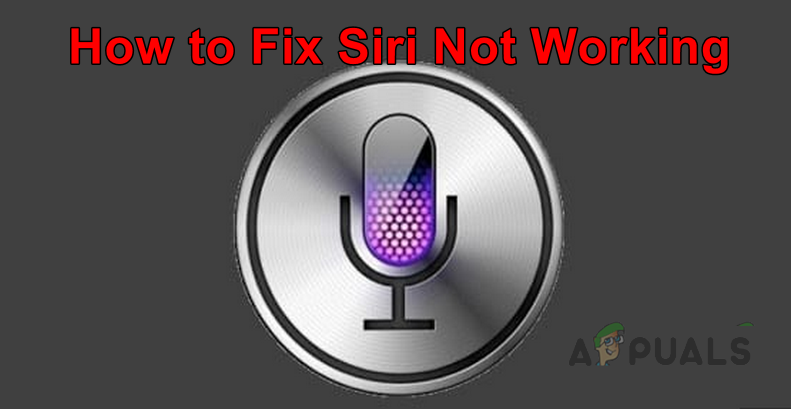
The following can be considered as the main reasons behind the non-working of Siri:
- Outdated OS of the Device: If the OS of your device is outdated, then its incompatibility with the updated Apple servers may not let Siri access the essential online resources and thus, cause the problem.
- Type to Siri Feature: The Siri on your iPhone might not work through the voice commands if it is configured to work with typing, not voice.
- Network and VPN Issues: You may encounter the Siri problem at hand if your ISP is hindering Siri’s communications with its servers. Moreover, if your iPhone is routing its traffic through a VPN, then the Apple servers may actively refuse connections from a VPN (Apple is known to block traffic from VPNs), resulting in the Siri issue under discussion.
- Corrupt Network or All Settings of the Device: If the network settings or any other settings of your iPhone are corrupt and not letting Siri load its essential modules in the device memory, then that could be the root cause of the non-working of Siri.
1. Clear the iPhone’s RAM
If there’s a background data build-up on the iPhone’s RAM and is glitching the phone’s RAM, then the glitched RAM may not let Siri execute properly. Here, clearing the iPhone’s RAM may clear the Siri issue.
For iPhone 8 & Below:
- Press and hold the power button of your iPhone till the power menu is shown.
- Now release the power button and immediately hold the iPhone’s Home button for 5 seconds (the Home screen may reappear).
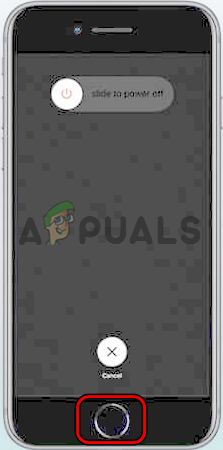
Press the Home Button on the iPhone’s Power Menu to Clear its RAM - Then head to the Siri Settings and do new voice recognition.
- Once done, check if Siri is working normally.
For iPhone X and Above:
- Launch iPhone Settings and open Accessibility.
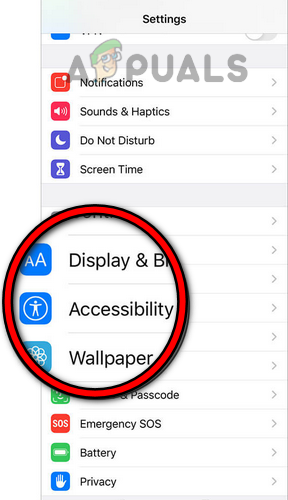
Open Accessibility in the iPhone Settings - Now select Touch and tap on Assistive Touch.
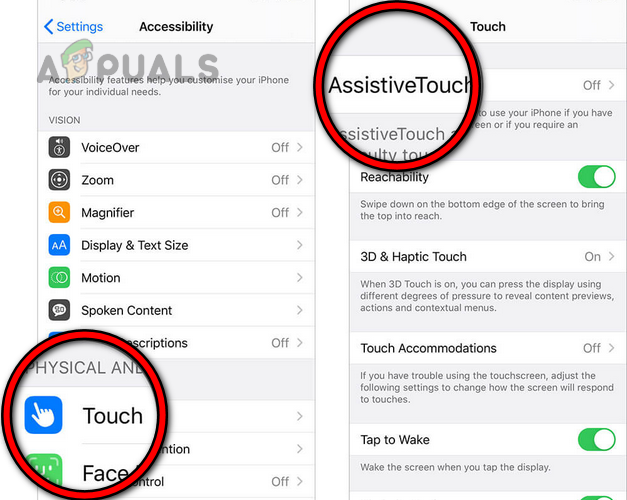
Open Assistive Touch in the Accessibility Settings of the iPhone - Then enable Assistive Touch by toggling its switch to the on position and hit the back button till you reach Settings.

Enable Assistive Touch in the iPhone Settings - Now open General and tap on Shut Down.

Shut Down iPhone from the General Menu - Then, on the power options screen, tap on the Assistive Touch icon and then tap/hold the Virtual Home button in the Assistive Touch options.

Press and Hold the Virtual Home Button to Clear the iPhone RAM - Now, wait till the iPhone’s Home or Lock screen is shown, and then leave the Assistive Touch’s Home button.
- Then steer to the Siri Setting and start new voice recognition.
- Once completed, check if Siri is operating fine.
2. Disable the ‘Do Not Disturb Mode’ of the iPhone
If the iPhone is in its Do not Disturb mode, then it may hinder the operation of Siri as modules essential for Siri may be disabled in the DND mode. In this scenario, disabling the Do Not Disturb mode of the iPhone may solve the problem.
For iOS 15 Devices:
- Launch the iPhone Settings and select Focus.
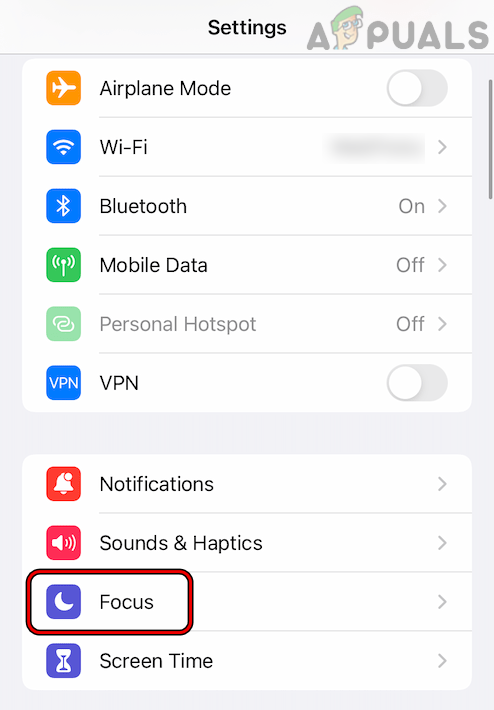
Open Focus in the iPhone Settings - Now open Do not Disturb and disable it by toggling its switch to the off position.

Open Do not Disturb in the Focus Settings of the iPhone - Once done, check if Siri is working normally.
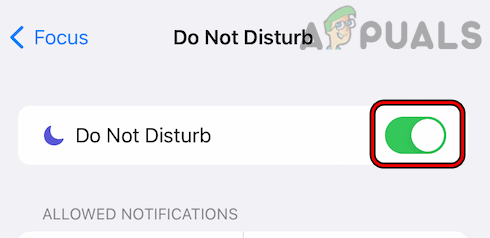
Disable Do Not Disturb Mode in the iPhone’s Focus Settings
For iOS 14 & Below Devices:
- Launch the iPhone Settings and select Do not Disturb.

Open Do Not Disturb Mode in the iPhone Settings - Now disable Do not Disturb by toggling its switch to the off position and afterward, check if Siri’s working problem is cleared.
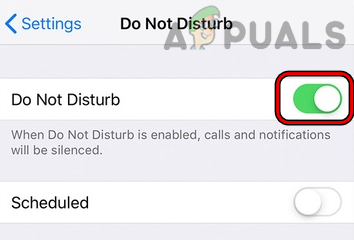
Disable Do Not Disturb Mode in the iPhone Settings
3. Perform a Force Restart of Your Device
A temporary glitch in the OS modules could stop Siri from working as Siri fails to access the modules essential for the Siri operation. In this context, performing a force restart of your device may clear the Siri error at hand. Although this article mainly covers the steps for an iPhone, the same steps can also be used on other Apple devices.
- Press and release the iPhone’s volume up button.
- Now press and immediately release the phone’s volume down button.
- Then press and hold the iPhone’s side button till the Apple logo is shown on the screen (do not release the button when the phone’s power menu is shown).
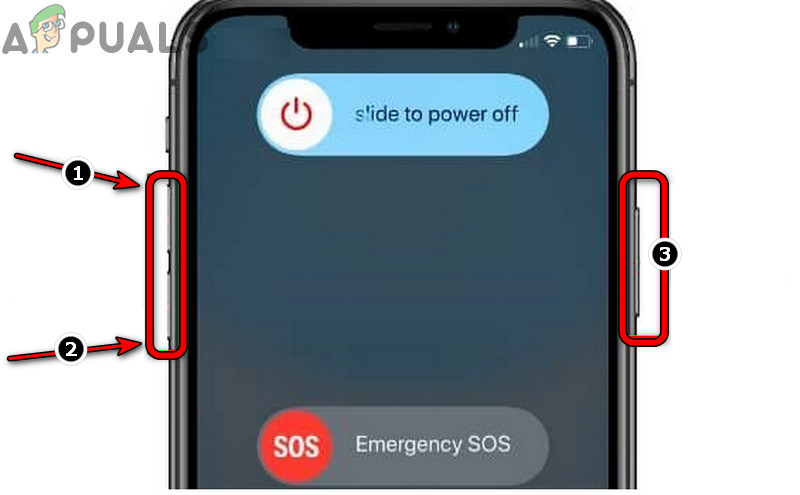
Force Restart the iPhone - Now, when the phone’s screen shows the Apple logo, release the phone’s side button and wait till the iPhone is properly powered on.
- Then check if Siri has started to work fine.
- If not, check if restarting your phone 5 times clears the error as there is a reported bug on the phone’s microphone that gets cleared when the phone is restarted 5 times and thus clears the Siri issue.
4. Disable and Enable Siri in the Device’s Settings
A temporary glitch in the Siri modules may not let you properly access Siri and its related features. In this case, disabling and enabling Siri in the device’s settings may solve the problem.
- Go to the iPhone Settings and open Siri & Search.
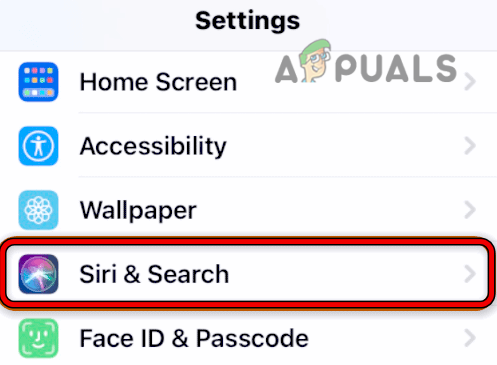
Open Siri & Search - Now disable the following options by toggling their respective switches to the off position:
Listen for “Hey Siri” Press Side Button for Siri" Allow Siri When Locked
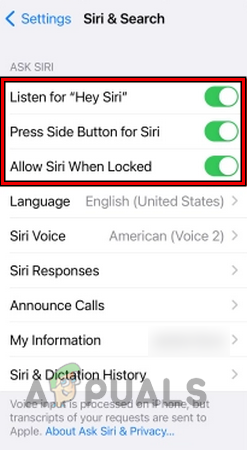
Disable Siri in the iPhone Settings - Then, in the pop-up shown, confirm to Turn Off Siri, and afterward, perform a force restart on your phone (as discussed earlier).
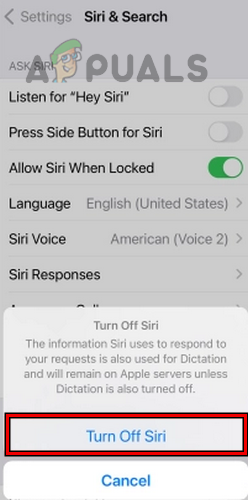
Tap on Turn Off Siri - Upon restart, enable Siri and set it up to check if it is working fine.
In the case, the issue is occurring with an Apple TV, check if connecting an audio output device to the TV (if the TV does not have speakers) resolves the issue.
5. Update the Device’s OS to the Latest Build
If your device’s OS is not updated to the latest build, then its incompatibility with the latest features of other services (like Siri) could cause the non-working of Siri as Siri may fail to query the Apple servers. In this context, updating the device’s OS (like an iPhone) to the latest build may solve the problem. Before proceeding, backup your phone, fully charge it, and connect it to a Wi-Fi network.
- Go to iPhone Settings and open General.
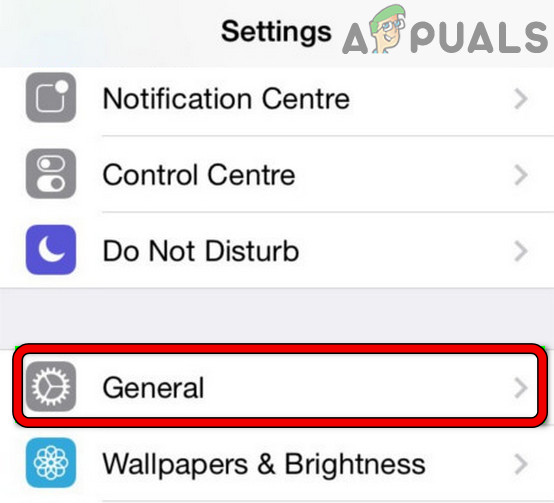
Open General Settings of iPhone - Now select Software Update and check if an iOS update is available.

Update Software of iPhone - If available, download the update and then install it.
- Once installed, restart your system, and upon restart, check if Siri is working fine.
6. Clean Your iPhone
If debris or dust has accumulated around the mic used by Siri, then Siri may fail to “understand” your command and thus may not execute it. In this case, cleaning your iPhone, especially the mic area, may solve the problem.
- Use a dry Q-tip to clean the area around the mics of the iPhone. You can also use a dry toothbrush with super soft bristles to clean the iPhone’s mics. Be careful, not to damage any hardware.
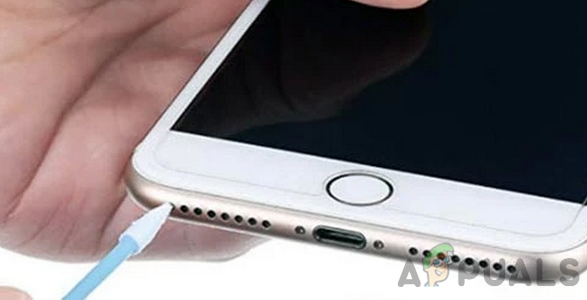
Clean Mics of the iPhone - Once cleaned, check if Siri is working fine.
- If that did not work, check if Siri works fine through a headset or Air Pods. If so, then check if the iPhone’s mics are working fine. You may try a voice test to confirm.
- If that fails and the issue is occurring when calling a number or a contact, then check if removing punctuation (like a comma) or special characters (like a hash sign) from the phone number of the contact clears the error.
7. Set Siri to Respond Always
If the Siri feature is not configured to respond always, then that may cause the issue at hand as Siri may ignore different commands under different circumstances (like in handsfree mode). In this context, setting Siri to respond always may solve the problem.
- Launch the iPhone Settings and open General.
- Now select Accessibility and tap on Siri.
- Then select Always-On and enable Always Listen for “Hey Siri” by toggling its switch to the ON position.

Set Siri to Always Run in the iPhone’s Accessibility Settings - Now check if Siri is clear of the working issue.
- If the issue persists, check if putting the iPhone on charging and then using Siri clears the problem.
8. Disable and Enable Dictation of the Device
Siri may fail to work properly if the dictation feature of the iPhone’s keyboard is disabled as Siri relies on some of the dictation modules to execute properly. Here, enabling (or disabling/enabling) the dictation feature of the iPhone’s keyboard settings may solve the problem.
- Go to iPhone Settings and select General.
- Now open the Keyboard and enable dictation by toggling the status switch of Enable Dictation to the on position. If the dictation feature is already enabled, then disable it, wait for a minute, and afterward, enable it.
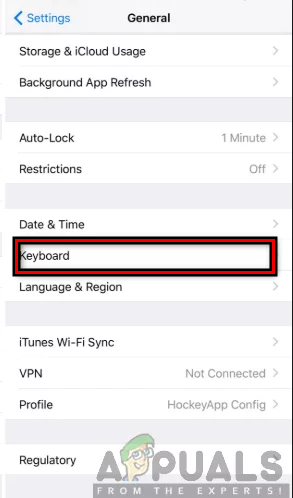
Open Keyboard in the General Settings of the iPhone - Then check if the Siri is working normally.
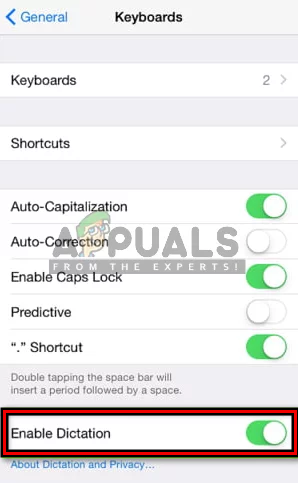
Enable Dictation in the iPhone’s Keyboard Settings
9. Disable Type to Siri in the Device’s Accessibility Settings
If the ‘Type to Siri’ in the device’s settings is enabled, then Siri may not respond to voice commands as it is waiting for a command through typing. Disabling the ‘Type to Siri’ in the device’s accessibility settings may solve the problem.
- Go to the iPhone Settings and open General.
- Now select Accessibility and open Siri.
- Then disable Type to Siri by toggling its status switch to off.

Disable Type to Siri in the Accessibility Settings of the iPhone - Now restart your iPhone and upon restart, check if Siri is responding to your commands.
10. Disable VPN on the iPhone
If your iPhone is routing its traffic from a VPN, then the VPN’s non-compliance with the web traffic generated by Siri can cause the issue at hand. Here, disabling the VPN on the iPhone may solve the problem.
- Launch the iPhone Settings and select General.
- Now open VPN & Device Management or VPN.
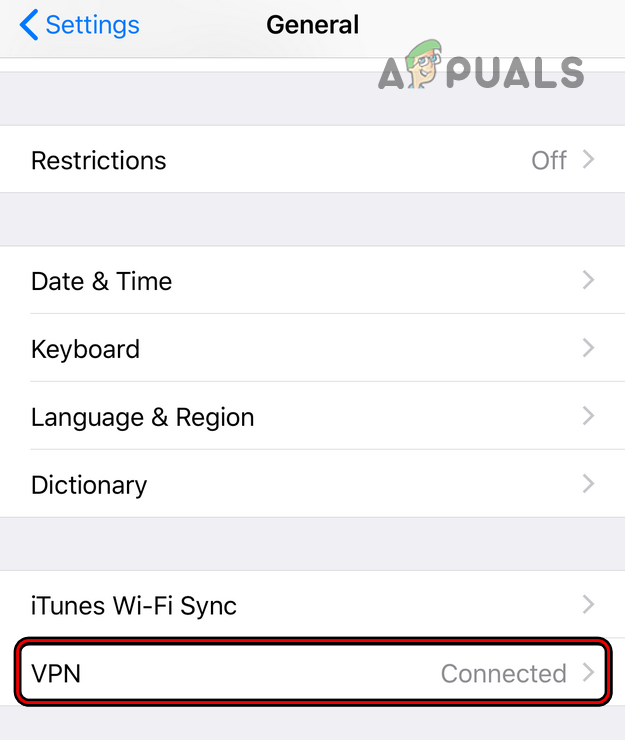
Open VPN in General Settings of iPhone - Then disable VPN by toggling its status switch to the off position and afterward, check if Siri is operating fine.
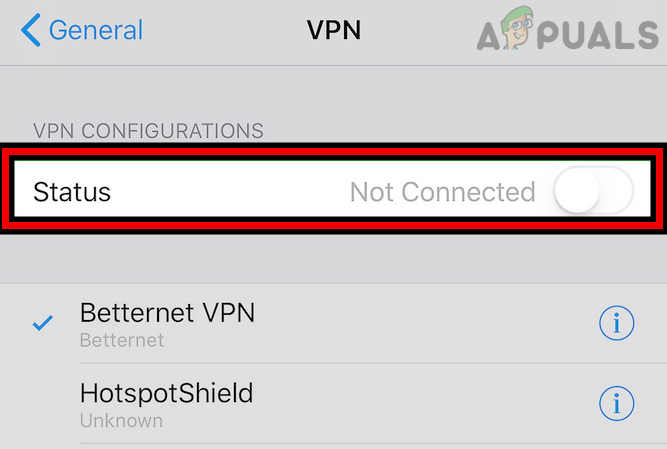
Disable VPN in the iPhone Settings
11. Disable Bluetooth of the iPhone
If your iPhone is connected to a Bluetooth device or Siri “thinks” it does, then Siri may keep on waiting to receive commands from that device while ignoring your commands from iPhone’s internal mic, which may result in the Siri issue at hand. In this case, giving commands through the connected Bluetooth device (like a speaker with a mic) or disabling Bluetooth on your iPhone may solve the problem.
- If your iPhone is connected to a Bluetooth device with a mic (like a speaker with a mic), check if speaking on that device makes Siri work.
- If not or the iPhone is not connected to a Bluetooth device, launch the iPhone Settings and open Bluetooth.
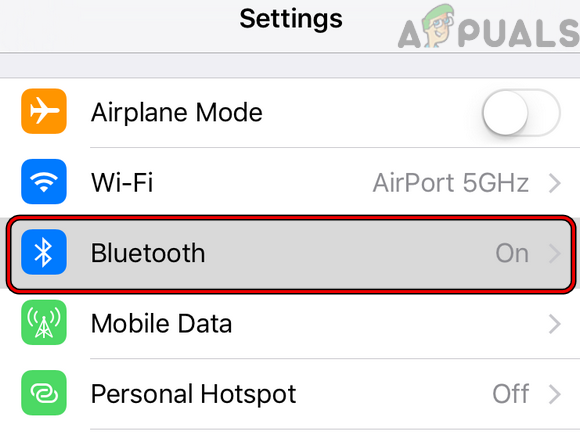
Open Bluetooth in the iPhone Settings - Now disable Bluetooth by toggling its switch to Off and then check if Siri has started to work normally.
12. Disable Noise Cancellation of the iPhone
If your device is configured to cancel the noise from the phone’s audio input, then that may cause the non-working of Siri as Siri’s AI fails to process the altered audio command. Here, disabling the noise cancellation feature of the iPhone may solve the problem.
- Launch the iPhone Settings and open General.
- Now select Accessibility and open Audio/Visual.
- Then disable Phone Noise Cancellation by toggling its switch to the off position and afterward, check if the Siri has started to work fine.
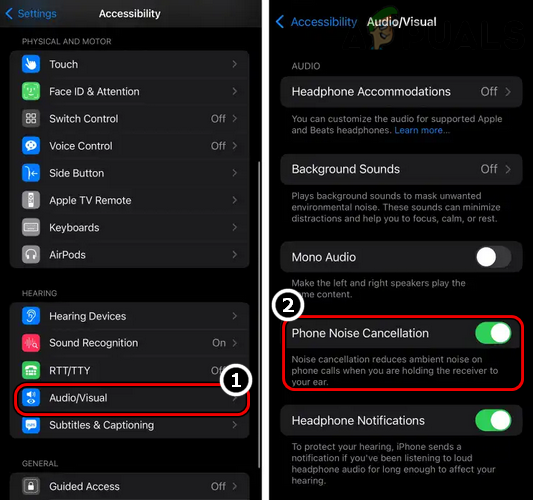
Disable Phone Noise Cancellation in the iPhone’s Accessibility Settings
13. Disable Sound Recognition of the iPhone
The iPhone’s Siri module may fail to work correctly if the iPhone’s Sound Recognition feature is enabled as this feature listens to the surrounding voices around the iPhone and may supersede Siri’s working mechanism. In this context, disabling the Sound Recognition feature of the iPhone may solve the problem.
- Launch the iPhone’s Settings and open Accessibility.
- Now select Sound Recognition and disable Sound Recognition by toggling its switch to the off position.

Open Sound Recognition in the iPhone’s Accessibility Settings - Then check if the iPhone’s Siri is operating fine.
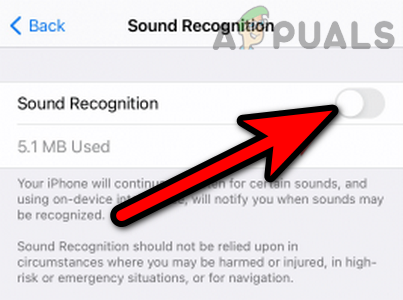
Disable Sound Recognition in the iPhone Settings
If the issue is occurring with a TV, check if using a different cable like an HDTV clears out the error.
14. Change Siri’s Input Language
If the Siri’s input language modules are glitched out, then the Siri may fail to “understand” the command given. Here, changing Siri’s input language may clear the issue.
- Launch the iPhone Settings and select General.
- Now open Siri and tap on Language.

Change Siri Language - Then select a native English language variant i.e., English (United Kingdom) or English (United States).
- Now restart your device and upon restart, check if Siri is working fine.
15. Change Siri Voice on the iPhone
If the profile of Siri’s voice in use (like the default Female American) is corrupt, then that may not let Siri respond to your command and cause the issue at hand. Here, changing the Siri Voice on the iPhone may solve the problem.
- Launch the iPhone Settings and open Siri & Search.
- Now tap on Siri Voice and select another voice like British Female (preferably) or Australian Female.
- Then check if Siri has started to operate normally.
- If that did not work, change the Siri voice again and then force restart the iPhone to check if it is clear of the issue.
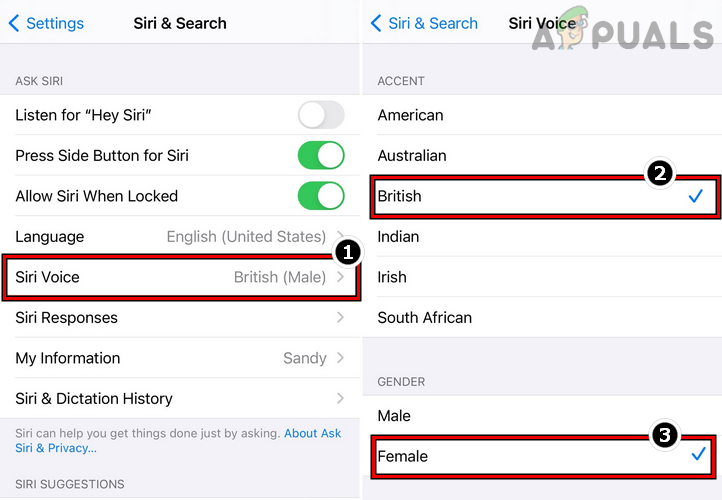
Change Siri Voice on the iPhone - If not, change Siri’s voice to USA Female and disable Siri (discussed earlier).
- Now enable Siri and then restart your phone to check if the Siri issue is resolved.
16. Disable Raise to Speak in the Apple Watch Settings
If ‘Raise to Speak’ is enabled in the Apple Watch settings, then the Hey Siri phrase may not activate Siri if your wrist is not raised. In this context, disabling Raise to Speak in the Apple Watch settings may solve the problem.
- Launch the Apple Watch Settings and open Siri.
- Now disable Raise to Speak by toggling its switch to off and then check if Siri is operating normally.
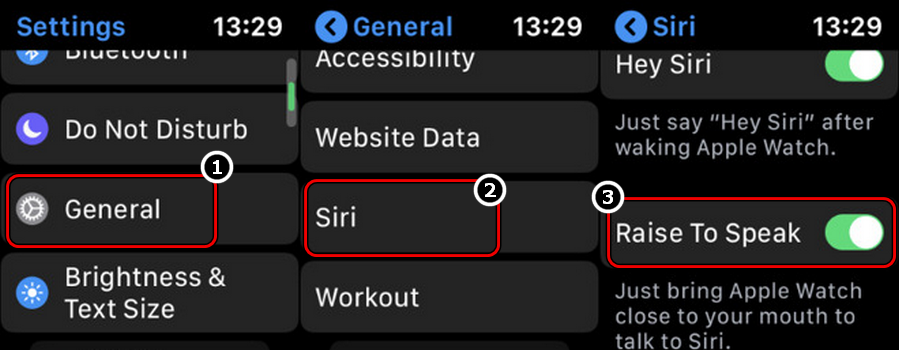
Disable Raise to Speak in the Apple Watch Settings
17. Use the Hardware Button to Enable Siri
A temporary glitch might not let Siri work and firstly activating it through the hardware button may clear the glitch and thus solve the problem.
- Launch iPhone Settings and open Siri & Search.
- Now enable Press Side Button for Siri by toggling its status switch to on.
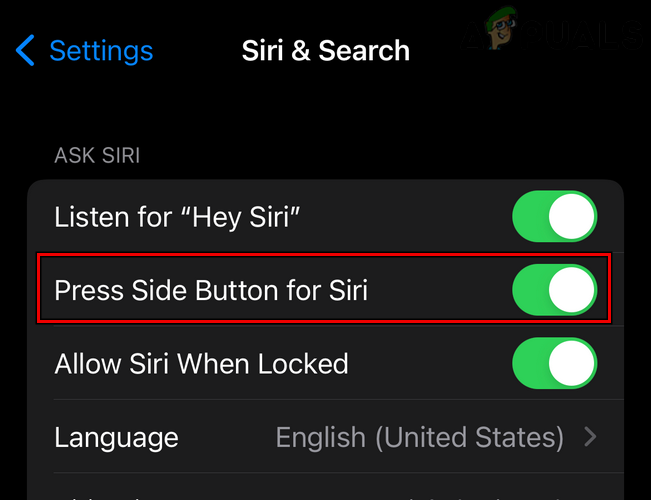
Enable Press Side Button for Siri in the iPhone’s Siri Settings - Then put the iPhone in standby mode and press/hold the side button for a few seconds.
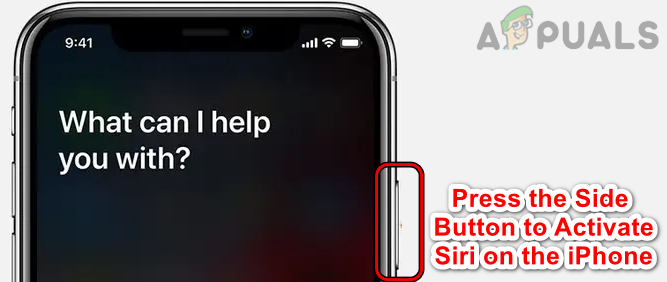
Press the Side Button to Activate Siri on the iPhone - Once Siri shows up, ask a simple question and check if Siri responds.
- If so, manually head to the Siri & Search in the iPhone Settings and press/hold the iPhone’s side button.
- Now when Siri shows up, check if it has started to work normally.
- If not, head to Siri & Search in the iPhone Settings and disable Listen for Hey Siri.
- Then disable Press Side Button for Siri and restart your iPhone.
- Upon restart, enable Listen for Hey Siri and Press Side Button for Siri.

Disable Listen for Hey Siri and Press Side Button for Siri in the iPhone’s Siri Settings - Then check if Siri is working fine.
- If not, check if repeating steps 3 to 6 resolves the Siri issue.
- If the issue persists, check if plugging and unplugging a headphone into the iPhone resolves the issue.
- If that did not work, disable Siri and all of its related features in the iPhone Settings.
- Now disable all the audio-related settings of the iPhone (like text/spoken content, etc.) and perform a force restart (discussed earlier) on your iPhone.
- Then enable back all the settings disabled previously and afterward, check if Siri is working fine.
18. Try Another Network or Network Type
If your ISP is restricting Siri’s access to its servers, then that could result in the Siri issue at hand. Moreover, if the modules of a particular type of network connection (like cellular) are glitched, then that could also result in the problem under discussion. Here, trying another network or network type may clear the Siri issue.
- Open the iPhone’s Settings and open Wi-Fi.
- Then disable Wi-Fi and hit the back button.
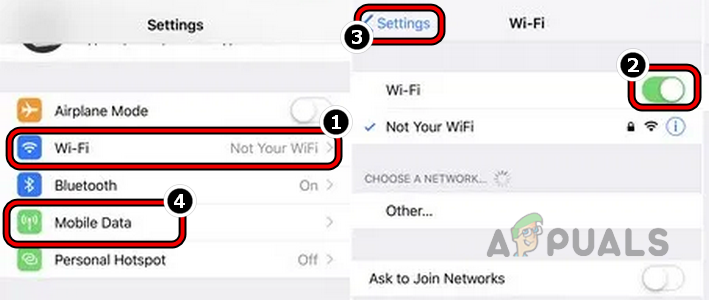
Disable Wi-Fi on the iPhone and Open Mobile Data - Now open Mobile Data or Cellular and enable it.
- Then check if Siri is working fine.
- If not, then disable Cellular and enable Wi-Fi to check if Siri has started to operate normally.
- If the issue persists, check if connecting the iPhone to another Wi-Fi network (preferably 2.4GHz) clears the error.
- If that did not work, check if enabling Roaming (you may be charged) in the iPhone’s settings resolves the issue.
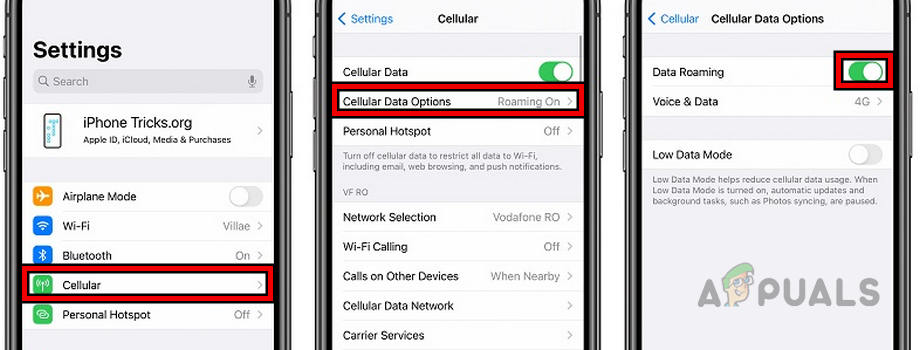
Enable Data Roaming on Your iPhone
19. Reset Network Settings of the iPhone to the Defaults
Siri might not work if the network settings of your iPhone are corrupt and due to this corruption, Siri fails to properly communicate with the Apple servers. Here, resetting the network settings of the iPhone to the defaults may clear the Siri problem at hand. Before moving on, make sure to note down the network-related information (like the Wi-Fi credentials) that are required later on to set up the network on your phone.
- Go to the Settings of your iPhone and open General.
- Now select Reset and tap on Reset Network Settings.
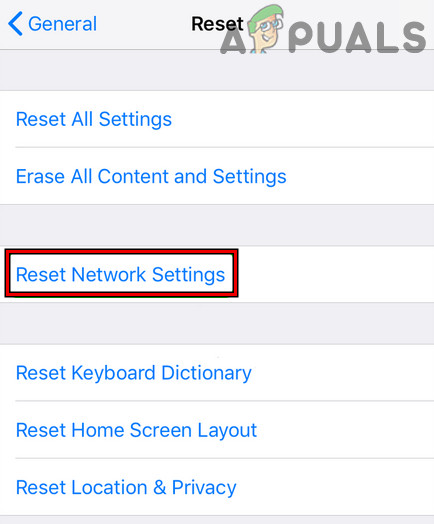
Tap on Reset Network Settings on iPhone - Afterward, confirm to reset your iPhone’s network settings, and re-setup the network (Wi-Fi or cellular) on your iPhone.
- Then check if Siri has started to operate normally.
20. Reset All Settings of the iPhone to the Defaults
If an improper configurational change in an iPhone setting is hindering Siri’s ability to work correctly or if an iPhone setting is corrupt, then that may result in the Siri issue under discussion. In this case, resetting all settings of the iPhone to the defaults may solve the problem. Before proceeding, note down the things that may be required later (like Wi-Fi credentials, etc.).
- Open the iPhone’s Settings and select General.
- Now open Reset and tap on Reset All Settings.
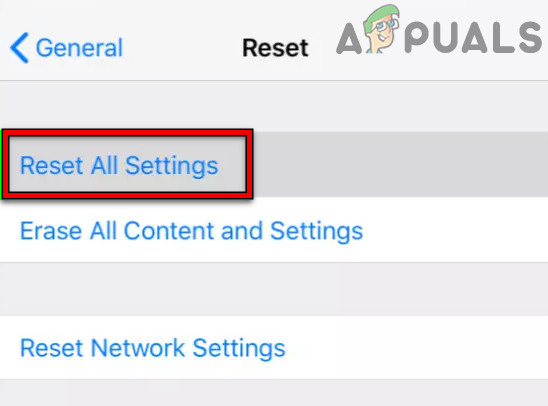
Reset All Settings on Your iPhone - Then confirm to reset all the iPhone’s Settings and afterward, connect your iPhone to the Internet (cellular or Wi-Fi).
- Now check if Siri is working fine once done.
21. Reset the iPhone to the Factory Defaults
If none of the above worked, then the corrupt OS of the iPhone could be the root cause of the Siri issue at hand, and performing the nuke option i.e., resetting the iPhone to the factory defaults may solve the problem. Before proceeding, make sure to backup the essential phone data.
- Launch iPhone Settings and open General.
- Now open Reset and press on Erase All Contents and Settings.
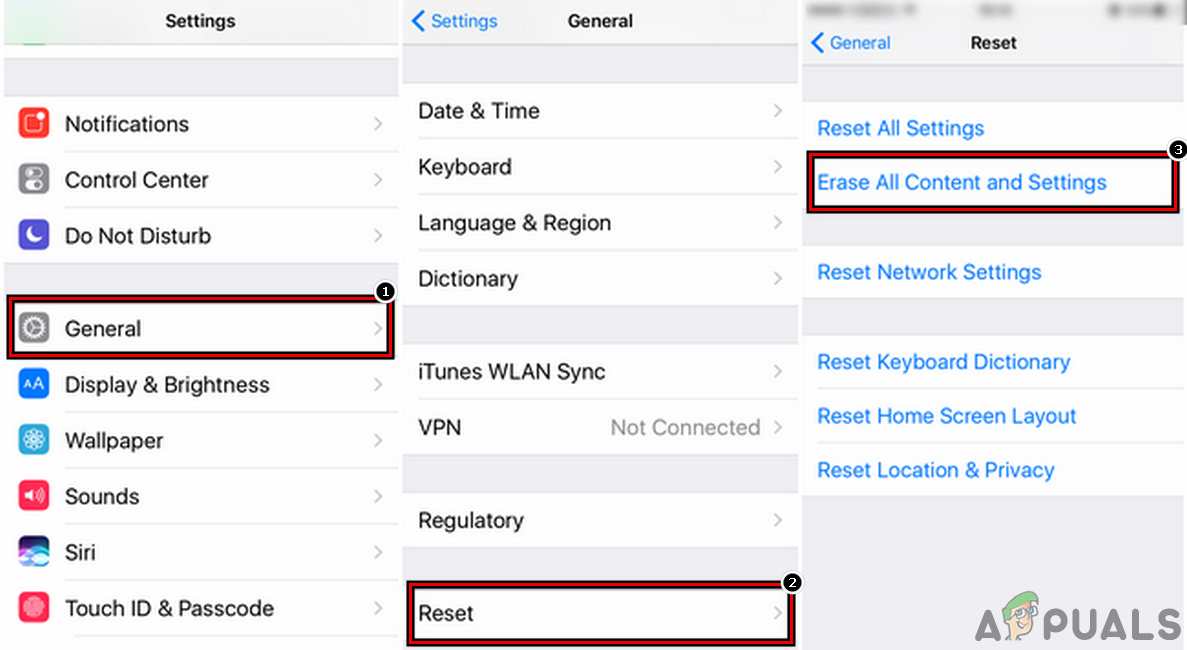
Erase All Content and Settings of iPhone - Then confirm to reset your iPhone to the factory defaults and wait till the process completes.
- Once done, set up the iPhone as a new device (do not restore from a backup yet) and configure Siri.
- Then launch Siri and hopefully, it will be working fine. If so, then you may restore the iPhone from the backup.
If that did not work, then you may contact iPhone support to resolve the Siri issue or get your iPhone checked for a hardware problem. If the issue occurs with an old Apple device, then you may edit its hosts file (at your own risk) to make Siri work for you.





